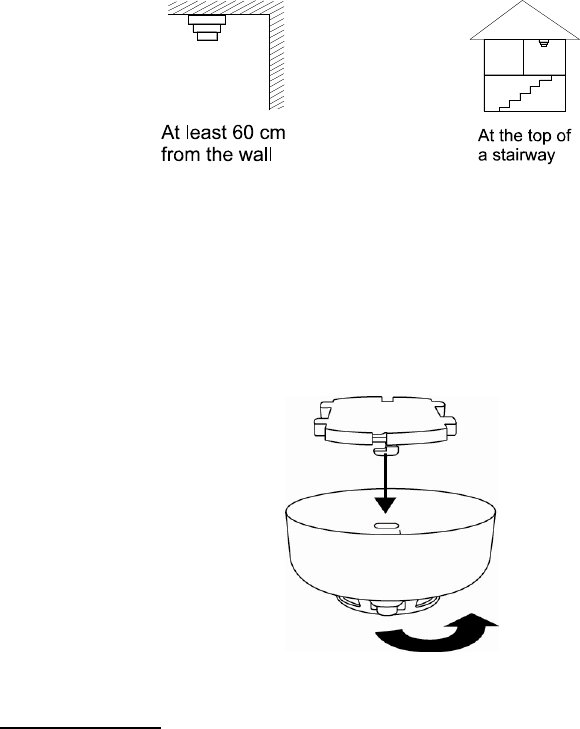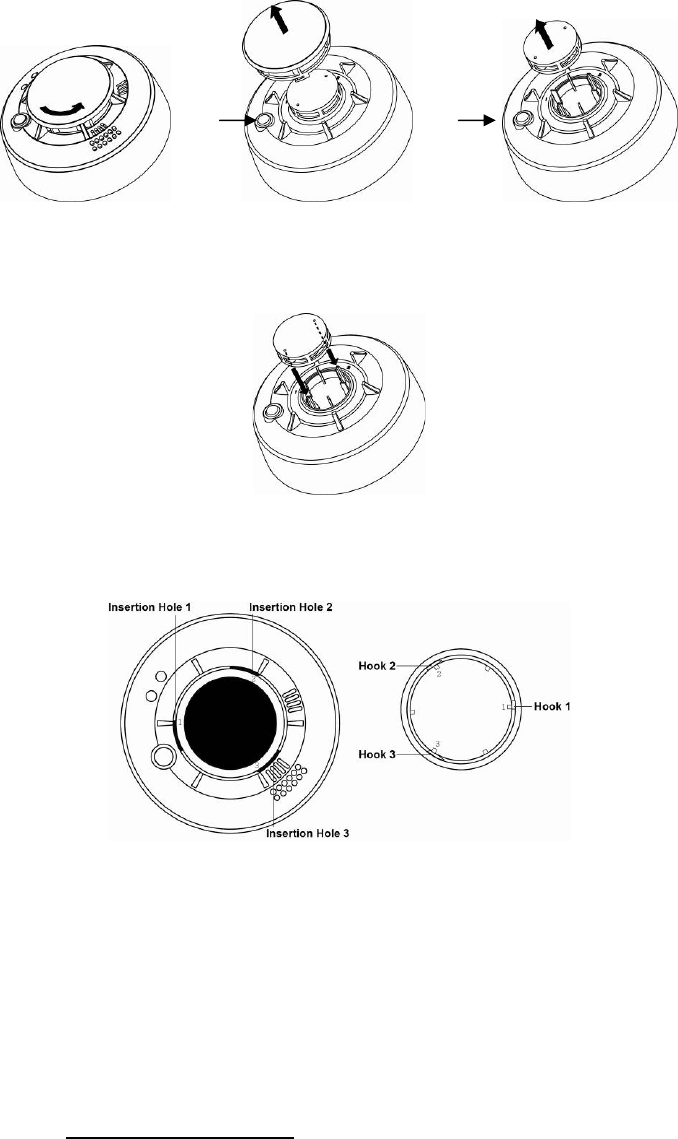Climax Technology Co SD16ZB Smoke Detector User Manual
Climax Technology Co Ltd Smoke Detector Users Manual
Users Manual

Smoke Detector
SD-16-ZBS / SD-16SL-ZBS
Introduction
SD-16(SL)-ZBS is a ZigBee Smoke Detector. It is capable of sending wireless signals to the coordinator
in the ZigBee network upon detection of smoke particles. The Smoke Detector is designed to be
mounted on ceiling or top of stairwells when smoke would concentrate to raise alarm timely and protect
your home from fire hazards.
The Smoke Detector utilizes ZigBee technology for wireless signal transmission. ZigBee is a wireless
communication protocol that is reliable and has low power consumption and high transmission efficiency.
Based on IEEE802.15.4 standard, ZigBee allows a large amount of devices to be included in a network
and coordinated for data exchange and signal transmission
The Smoke Detector serves as an end device in the ZigBee network. It can be included in the ZigBee
network to transmit signal upon activation, but cannot permit any other ZigBee device to join the network
through the Smoke Detector.
The SD-16 Series Smoke Detector includes following models, the models differ in battery used.
SD-16ZBS
SD-16SL-ZBS
Parts Identification
1. Red LED
- Continuous quick flashes
The Smoke Detector is alarming.
- Two quick flashes
The Smoke Detector has successfully joined a ZigBee network after
factory reset.
- Flashes once every 20 minutes:
The Smoke Detector has lost connection to its current ZigBee
network.
- Flashes every 4 seconds:
Battery Exhausted
- Flashes every 2 seconds:
The Smoke Detector is under warm-up and self-calibration process
- Flashes every second:
The Smoke Detector is in Alarm Silence mode.
2. Amber LED
- Flashes every 4 seconds:
Battery Exhausted
- Flashes every 5 seconds:
Auto-calibration has failed.
3. Function Button
- Press the button once to send a supervision signal / test Smoke
Detector
- Press the button once during alarm to silence the alarm.
- Press and hold the button for 10 seconds then release to reset the
Smoke Detector.
- Press and hold the button for 20 seconds then release to recalibrate
the Smoke Detector.
4. Buzzer
5. Mounting Hole
The Hook of the Mounting Bracket can hook into this Mounting Hole.
6. Battery compartment
The battery used varies according to Smoke Detector model number.
7. Battery Compartment Cover

8. Mounting Bracket
Features
Smoke Detection
The Smoke Detector will be activated whenever the smoke concentration exceeds the detection
threshold. After activation, the Red LED will flash quickly and the Smoke Detector will transmit
alarm signal and raise alarm with its built in buzzer for 8 seconds. The alarm sound will repeat in
pattern of 2-second alarm and 1-second pause.
The Smoke Detector will check smoke concentration every 8 seconds, if the smoke
concentration still exceeds detection threshold after 8 seconds, the buzzer will continue to
sound alarm and the LED will continue to flash.
If the smoke concentration remains above the detection threshold, the Smoke Detector will
continue to send the alarm signal every 2 minutes.
If the smoke concentration drops below detection threshold, the Smoke Detector will stop
alarming immediately, a restore signal will be transmitted if no alarm is activated again for 160
seconds.
Alarm Silence
When the Smoke Detector is alarming, you can press the Function button once on Smoke
Detector to transmit a cancel signal and enter Alarm Silence mode for 10 minutes
Under Alarm Silence mode, the Smoke Detector will not sound alarm; the LED Indicator will
flash every second to indicate it is under Alarm Silence mode.
After 10 minutes, if the smoke concentration still exceeds detection threshold, the Smoke
Detector will raise alarm and send alarm signal again.
Recalibration
The Smoke Detector will calibrate its sensor every time when power is applied to ensure optimal
smoke sensitivity. After installation, the operation condition of the Smoke Detector may vary after
some time, which may affect its smoke detection function and requires recalibration. There are two
ways to recalibrate the Smoke Detector: auto calibration and manual calibration.
Auto Calibration:
After power up, the Smoke Detector will perform auto-calibration after 4 hours.
After the first auto-calibration, the Smoke Detector will perform auto calibration every month.
During the auto-calibration process, the Smoke Detector will not emit any sound.
If auto-calibration fails the LED will flash rapidly and the Smoke Detector will send a calibration
fail signal to the ZigBee Network coordinator. To stop the LED from flashing, remove and reload
the batteries or start a new calibration process manually. If the manual calibration fails again,
Smoke Detector will emit continuous beeps. To stop the beeping sound and the flashing LED,
remove and reload the batteries.
When Smoke Detector auto calibration fails, the smoke alarm function will still work normally
using the threshold value taken from the last successful calibration.
Manual Calibration:
Manual calibration can be performed any time as desired:
1. Press and hold the function button for 20 seconds.
2. The Smoke Detector will emit 2 short beeps at after 10 seconds and 3 short beeps after 20
seconds. Keep holding the function button and release until you hear the 3 short beeps after 20
seconds.
3. The Smoke Detector will enter calibration process. The LED Indicator will flash every 2 seconds.
4. After the Smoke Detector finishes recalibration, it will emit two quick beeps to indicate. The LED
will turn off.
5. If calibration process fails, Smoke Detector will emit alarm sound. Please remove and reinsert
battery to restart process again.
Battery and Low Battery Detection
The battery used varies according to Smoke Detector model number.
Model Number Battery
SD-16-ZBS 2 AA Alkaline 1.5V Batteries
SD-16SL-ZBS 1 CR123A 3V Lithium Battery
The Smoke Detector feature Low Battery Detection function. When the battery voltage is low,
the Smoke Detector will transmit Low Battery signal to the coordinator in ZigBee network.
If batteries are not changed after low battery, the Smoke Detector will stop all function when
batteries are exhausted and flash both LEDs every 4 seconds to indicate failure.

When changing batteries, after removing the old batteries, press the Function Button twice to
fully discharge before inserting new batteries.
Supervision
The Smoke Detector will transmit a supervision signal to report its condition regularly according to
user setting. The factory default interval is 30 minutes. The user can also press the Function Button
once to transmit a supervision signal manually.
Test Smoke Detector
Press the Function button once during normal operation to test if Smoke Detector is functioning
normally.
If the Smoke Detector functions normally, the Red LED will turn on briefly and sound a
2-tone beep.
If the buzzer sounds 2-tone beeps 3 times, the “Optical Chamber” on the Smoke Detector
is either dirty or out-of-order.
If the Red LED doesn’t light up and no beep is sounded, it means the Smoke Detector is
out-of-order.
ZigBee Network Setup
ZigBee Device Guideline
ZigBee is a wireless communication protocol that is reliable and has low power consumption and
high transmission efficiency. Based on the IEEE802.15.4 standard, ZigBee allows a large amount of
devices to be included in a network and coordinated for data exchange and signal transmission.
Due to the fundamental structure of ZigBee network, ZigBee device will actively seek and join
network after powering on. Since performing a task in connecting network may consume some
power, it is required to follow the instructions to avoid draining battery of a ZigBee device
- Ensure your ZigBee network router or coordinator is powered on before inserting battery into the
ZigBee device.
- Ensure the ZigBee network router or coordinator is powered on and within range while a ZigBee
device is in use.
- Do not remove a ZigBee device from the ZigBee network router or coordinator without removing
the battery from a ZigBee device.
Joining the ZigBee Network
As a ZigBee device, the Smoke Detector needs to join a ZigBee network to transmit signal when
smoke concentration is detected. Please follow the steps bellow to join the Smoke Detector into
ZigBee network.
1. Insert the batteries into the battery compartment to power on the Smoke Detector.
2. The Smoke Detector will emit two short beeps, and then begin warm up for 1 minute, the LED will
flash every 2 seconds.
3. Joining ZigBee network is allowed during the 1-minute warm up period. Press and hold the
function button for 10 seconds and release to search for existing ZigBee network. Please make
sure the permit-to-join feature on the router or coordinator of your ZigBee network is enabled.
4. After joining the ZigBee network, the Smoke Detector will be registered in the network
automatically. Please check the ZigBee coordinator, security system control panel or CIE (Control
and Indicating Equipment) to confirm if joining and registration is successful.
5. After the 1-minute warm up period expires, the Smoke Detector will emit a beep to indicate it now
enters calibration process. The calibration process takes 2~7 minutes; the LED will continue to
flash during calibration. Joining ZigBee network is prohibited during calibration process.
6. When calibration is complete, the Smoke Detector will emit 2 beeps and LED will stop flashing to
indicate it is now under normal operation. If calibration fails, the Smoke Detector will sound
continuous beep.
7. Under normal operation, if the Smoke Detector loses connection to its current ZigBee network,
the LED indicator will flash every 20 minutes to indicate the situation. Please check your ZigBee
network condition and Smoke Detector signal range to correct the situation.
Removing Device from ZigBee Network (Factory Reset)
To remove the Smoke Detector from current ZigBee network, the Smoke Detector must be put to
Factory Reset to complete device removal. Factory Reset function will clear the Smoke Detector of
its stored setting and information and prompt the Smoke Detector to search for new ZigBee network.
Before removing device, make sure the Smoke Detector is within current ZigBee network
signal range
1. Press and hold the function button for 10 seconds, then release the button to reset Smoke
Detector.

2. Upon reset, the Smoke Detector will clear current ZigBee network setting and transmit signal to
ZigBee coordinator to remove itself from current ZigBee network. It will then actively search for
available ZigBee network again and join the network automatically.
Factory Reset
If you want to remove the Smoke Detector from current network and join a new network, you need to
use the Factory Reset function to clear the Smoke Detector of its stored setting and information first
before it can join another network. To perform Factory Reset:
1. Press and hold the function button for 10 seconds, release the button upon hearing two short
beeps.
2. The Smoke Detector has been reset to factory default setting with all its previous network
information removed. It will now actively search for available ZigBee network again and join the
network automatically.
3. If the Smoke Detector successfully joins a ZigBee network, the LED Indicator will flash twice to
indicate.
Installation
Installation Guideline
It is recommended to install the Smoke Detector at the center of the ceiling, or top of stairwell
with at least 60 cm of space between the Smoke Detector and the wall
Do not install the Smoke Detector in the following locations:
The Kitchen – Smoke from cooking might cause an unwanted alarm.
Near a ventilating fan, florescent lamp or air-conditioning equipment – air drafts from
them may affect the sensitivity of the detector.
Near ceiling beams or over a cabinet – stagnant air in these areas may affect the
sensitivity of the detector.
In the peak of an “A” frame type of ceiling.
Mounting the Smoke Detector
The Smoke Detector has a mounting bracket for mounting on ceiling.
1. Use the mounting bracket as template to mark the two holes on ceiling for installing screws.
2. Screw the mounting bracket onto the ceiling according to marked location. Install wall plugs if
necessary.
3. Locate the hooks of the mounting bracket and line up the hooks with the mounting holes on the
Smoke Detector. Fit the hooks into the mounting holes, then rotate the Smoke Detector
counter-clockwise to lock it into the mounting bracket. Mounting the Smoke Detector is now
complete.
Using Smoke Detector with ZigBee Router
IMPORTANT NOTE
If the Smoke Detector installation location is away from your system control panel and requires

ZigBee routers to improve signal strength. DO NOT use a ZigBee Router without backup battery. A
ZigBee router without battery will be powered down during AC power failure and the Smoke
Detector connected to the router will lose connection with ZigBee network. You should plan your
Smoke Detector installation location using only ZigBee router with backup battery.
Maintenance
The top cover and the smoke detecting chamber can be detached from the Smoke Detector for
maintenance. Follow the steps below to maintain the smoke detecting chamber:
1. Remove the top cover by rotating the top cover counter-clockwise, then remove the smoke
detecting chamber
2. Pull out the anti-insect mesh inside the chamber and clean the chamber and mesh with a brush or
water.
3. Re-insert the anti-insect mesh into the chamber and insert the chamber back onto the Smoke
Detector. Please make sure the chamber is dry before re-inserting back onto the Smoke Detector.
4. Insert the top cover back onto the Smoke Detector. The top cover includes 3 insertion hooks to fit
into the Smoke Detector. Each hook has a number next to it. Match these numbers with the
numbers of insertion holes on the Smoke Detector.
Appendix (For developers only)
Smoke Detector Cluster ID

Device ID: IAS Zone 0x402
Endpoint: 0x01
Server Side Client Side
Mandatory
Basic (0x0000) None
Identify(0x0003)
IAS Zone(0x0500)
Optional
None None
Attribute of Basic Cluster Information
Identifier Name Type Range Access Default
Mandatory
/ Optional
0x0000 ZCLVersion Unsigned 8-bit
integer 0x00 –0xff Read
only 0x01 M
0x0001 ApplicationVersion
Unsigned 8-bit
integer 0x00 –0xff Read
only 0x00 O
0x0003 HWVersion Unsigned 8-bit
integer 0x00 –0xff Read
only 0 O
0x0004 ManufacturerName Character
String 0 – 32 bytes Read
only Climax
Technology O
0x0005 ModelIdentifier Character
String 0 – 32 bytes Read
only (Model Version) O
0x0006 DateCode Character
String 0 – 16 bytes Read
only O
0x0007 PowerSource 8-bit 0x00 –0xff
Read
only M
0x0010 LocationDescription Character
String 0 – 32 bytes Read /
Write O
0x0011 PhysicalEnvironment 8-bit 0x00 –0xff
Read /
Write 0x00 O
0x0012 DeviceEnabled Boolean 0x00 –0x01
Read /
Write 0x01 M
Attribute of Identify Cluster Information
Identifier Name Type Range Access Default
Mandatory
/ Optional
0x0000 IdentifyTime Unsigned
16-bit integer 0x00 –0xffff Read /
Write 0x0000 M
Attribute of IAS Zone Cluster Information
Identifier Name Type Range Access Default
Mandatory
/ Optional
0x0001 ZoneState 8-bit
Enumeration All Read
only 0x00 M
0x0002 ZoneType 8-bit
Enumeration All Read
only M
0x0003 ZoneStatus 16-bit bitmap All Read
only 0x00 M
0x0010 IAS_CIE_ADDRESS IEEE
ADDRESS Valid 64bit
IEEE address Read /
Write M
0x0011 ZONE_ID Unsigned 8-bit
integer All Read
only 0xFF M
Federal Communication Commission Interference Statement
This equipment has been tested and found to comply with the limits for a Class
B digital device, pursuant to Part 15 of the FCC Rules. These limits are
designed to provide reasonable protection against harmful interference in a
residential installation.
This equipment generates, uses and can radiate radio frequency energy and, if
not installed and used in accordance with the instructions, may cause harmful
interference to radio communications. However, there is no guarantee that
interference will not occur in a particular installation. If this equipment does
cause harmful interference to radio or television reception, which can be
determined by turning the equipment off and on, the user is encouraged to try
to correct the interference by one of the following measures:
. Reorient or relocate the receiving antenna.
. Increase the separation between the equipment and receiver.
. Connect the equipment into an outlet on a circuit different from that to which
the receiver is connected.
. Consult the dealer or an experienced radio/TV technician for help.
FCC Caution: To assure continued compliance, any changes or modifications
not expressly approved by the party responsible for compliance could void the
user's authority to operate this equipment. (Example - use only shielded
interface cables when connecting to computer or peripheral devices).
FCC Radiation Exposure Statement
This equipment complies with FCC RF radiation exposure limits set forth for an
uncontrolled environment. This equipment should be installed and operated
with a minimum distance of 20 centimeters between the radiator and your
body.
This transmitter must not be co-located or operating in conjunction with any
other antenna or transmitter.
The antennas used for this transmitter must be installed to provide a
separation distance of at least 20 cm from all persons and must not be
co-located or operating in conjunction with any other antenna or transmitter.
This device complies with Part 15 of the FCC Rules. Operation is subject to the
following two conditions:
(1) This device may not cause harmful interference, and
(2) This device must accept any interference received, including interference
that may cause undesired operation.